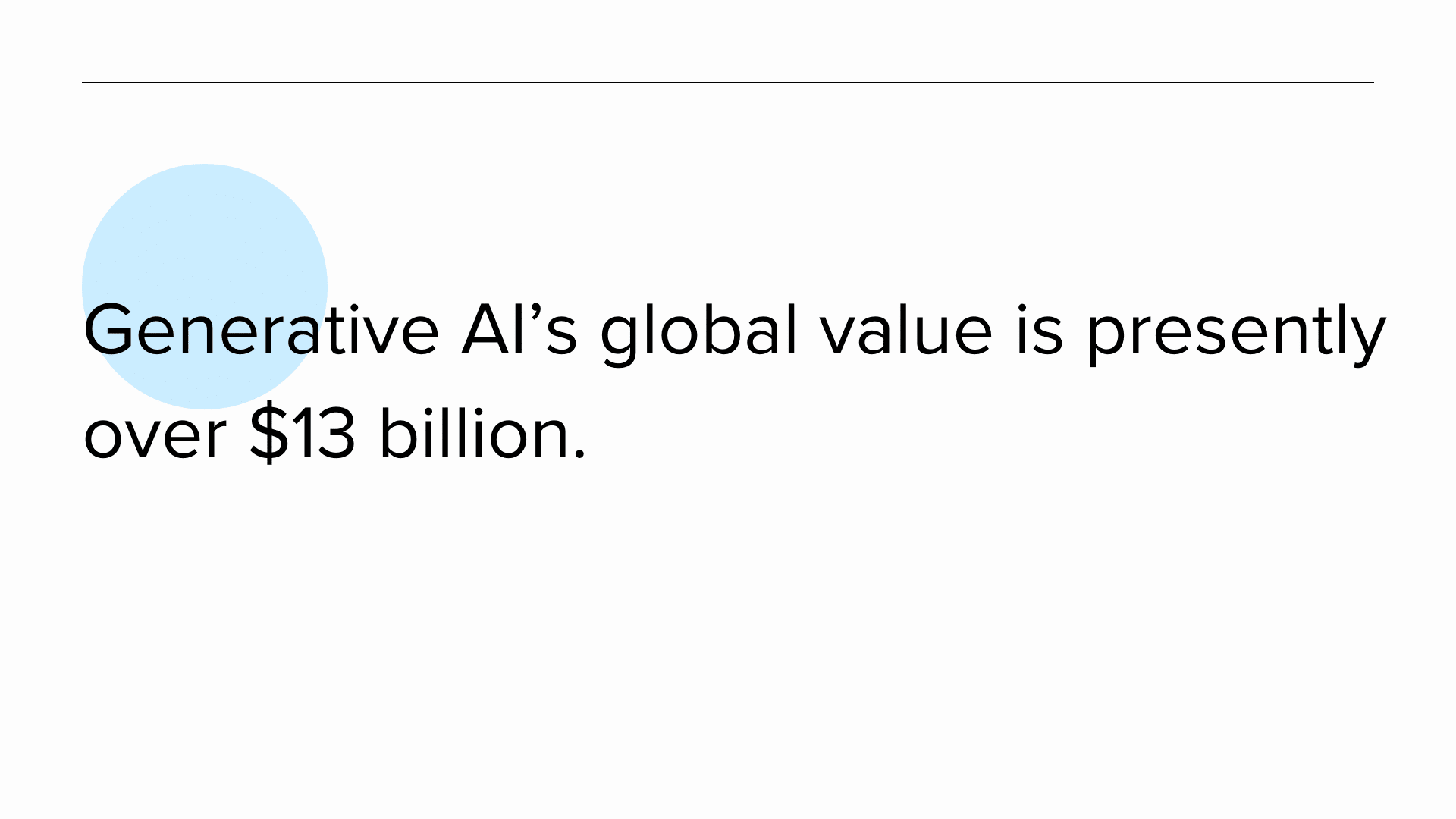Artificial intelligence has been a topic of interest for several years, and has come a long way since its inception. Today, one of the fastest growing fields in AI is generative AI. This technology has advanced significantly in recent years, and is being used across various industries. In this article, we will take a closer look at the generative AI market, its size, trends, and statistics for the years 2023 to 2025. Lets deep dive into Generative AI Market Size

Introduction to Generative AI
Generative AI is a type of artificial intelligence that involves using machine learning algorithms to generate new content, such as images, music, and text. It uses deep learning models to generate new output that is similar to the input it has been trained on, but has unique characteristics of its own.
- The generative AI market is valued at $11.3 billion USD
- It’s projected to cross $22 billion by 2025.
- The sector is growing at a 27.02% CAGR.
- North America has a 41% revenue share.
- Transformer models constituted 42% of 2022’s revenue.
Generative AI is a rapidly growing field that has the potential to revolutionize the way we create and consume content. By using algorithms to generate new content, we can save time and resources while still producing high-quality output. This technology has already been used to create everything from virtual try-on experiences to personalized healthcare solutions.
What is Generative AI?
Generative AI is a technology that can create new content using algorithms. It is a subset of AI that involves using neural networks to generate new content that is similar to the input it has been trained on. The goal of generative AI is to create output that is not only similar to the input, but also has unique characteristics of its own.
Generative AI can be used to create a wide range of content, including images, music, and text. It can be used to generate new product designs, marketing campaigns, and even entire websites. By using generative AI, companies can save time and resources while still producing high-quality output.
Read More: How To Provide An AI Experience For Your Customers?
Key Applications of Generative AI
Generative AI has a wide range of applications in various industries. In the retail industry, it can be used to create virtual try-on experiences for customers. By using generative AI, customers can see what a product will look like on them without having to physically try it on. This can save time and resources for both the customer and the retailer.
By using generative AI, companies can create high-quality content quickly and efficiently, without having to rely on human designers or writers, thereby improving customer support with AI
In the retail industry, the use of AI has revolutionized customer experiences. For example, with a Shopify CRM, businesses can leverage AI to enhance customer engagement and sales.
In the healthcare industry, generative AI can be used to create personalized healthcare solutions for patients. By analyzing patient data, generative AI algorithms can create customized treatment plans that are tailored to the individual patient’s needs. This can lead to better patient outcomes and more efficient use of healthcare resources.
Generative AI can also be used in the gaming industry to create more realistic avatars for players. By using generative AI, game developers can create avatars that are unique to each player and that evolve over time based on the player’s actions in the game.
In other industries, generative AI can be used to create content for marketing campaigns or to generate new product designs. By using generative AI, companies can create high-quality content quickly and efficiently, without having to rely on human designers or writers.
Overall, generative AI is a rapidly growing field that has the potential to revolutionize the way we create and consume content. By using algorithms to generate new content, we can save time and resources while still producing high-quality output that is tailored to the needs of our customers and clients.
Market Overview
The generative AI market is growing rapidly and is expected to continue to grow over the next few years. According to market research, the global generative AI market size is expected to reach $4.5 billion by 2023.
Generative AI is a form of artificial intelligence that can generate content, such as images, videos, and music, without human intervention. This technology has the potential to revolutionize various industries, including healthcare, retail, gaming, and marketing.
Market Size and Growth
The generative AI market size is growing at a rapid pace due to the increasing demand for AI systems that can generate content. The market is expected to grow at a CAGR of over 20% from 2020 to 2025. This growth is being driven by advancements in machine learning algorithms, which have made it possible to create more complex generative AI systems.
One of the key drivers of growth in the generative AI market is the increasing demand for personalized content. With generative AI, companies can create unique content for each customer, based on their preferences and behavior. This can help companies to improve customer engagement and drive sales.
Market Segmentation
The generative AI market is segmented by application, deployment, and end user. By application, the market is segmented into image and video generation, text generation, music generation, and others. By deployment, the market is segmented into cloud-based and on-premise. By end user, the market is segmented into healthcare, retail, gaming, marketing and advertising, and others.
Image and video generation is expected to be the largest segment of the generative AI market, due to the increasing demand for visual content across various industries. Text generation is also expected to grow at a rapid pace, due to the increasing demand for personalized content in marketing and advertising.
Regional Analysis
The generative AI market is divided into four main regions: North America, Europe, Asia Pacific, and the rest of the world. North America is expected to dominate the market due to the presence of major players in the region. Asia Pacific is expected to grow at a rapid pace due to the increasing adoption of AI across various sectors.
In North America, the United States is expected to be the largest market for generative AI, due to the presence of major technology companies in the region. In Europe, the United Kingdom and Germany are expected to be the largest markets for generative AI, due to the increasing adoption of AI in various industries. In Asia Pacific, China and Japan are expected to be the largest markets for generative AI, due to the increasing investment in AI research and development.
Overall, the generative AI market is expected to continue to grow at a rapid pace over the next few years, driven by the increasing demand for personalized content across various industries.
Key Trends Shaping the Generative AI Market
The generative AI market is constantly evolving, and is being shaped by several key trends. These trends are driving growth and innovation in the market, and are opening up new possibilities for applications of the technology.
Technological Advancements
Technological advancements in machine learning algorithms are driving the growth of the generative AI market. These advancements have made it possible to create more complex generative AI systems that can generate highly realistic and unique content.
One of the key technological advancements in this field is the development of deep learning algorithms. These algorithms use neural networks to learn from large datasets and generate new content that is similar to the original data. This has opened up new possibilities for applications of generative AI in fields such as art, music, and literature.
Another important technological advancement is the development of natural language processing (NLP) algorithms. These algorithms can generate human-like text, which can be used for a variety of applications such as chatbots, content creation, and language translation.
Increasing Adoption in Various Industries
The adoption of generative AI is increasing across various industries due to the benefits it offers. One of the main benefits is the ability to save time and resources by automating certain tasks. For example, generative AI can be used to automatically generate product descriptions, social media posts, and even entire websites.
Generative AI can be used to create unique content for each customer, based on their preferences and behavior, enhancing platforms such as WhatsApp commerce
Another benefit of generative AI is the ability to generate unique content that can be used in various applications. For example, generative AI can be used to create personalized marketing content for individual customers, or to generate unique music compositions for film scores.
Industries that are currently adopting generative AI include advertising, entertainment, and e-commerce. However, there is potential for the technology to be used in a wide range of industries, including healthcare, finance, and education.
Growing Investment in AI Research and Development
There is a growing investment in AI research and development across the globe. This investment is driving innovation in the generative AI market, as new technologies are being developed that can generate even more complex content.
One area of research that is receiving significant investment is the development of generative adversarial networks (GANs). GANs are a type of deep learning algorithm that can generate highly realistic content, such as images and videos. This technology has the potential to revolutionize fields such as gaming, virtual reality, and film production.
Another area of research that is receiving investment is the development of AI systems that can generate content in multiple modalities, such as text, images, and audio. This technology has the potential to create highly immersive and interactive experiences in fields such as gaming and virtual reality.
Overall, the generative AI market is rapidly evolving, driven by technological advancements, increasing adoption in various industries, and growing investment in AI research and development. As the technology continues to develop, it is likely that we will see even more innovative applications of generative AI in the future.
Challenges and Opportunities in the Generative AI Market
The generative AI market is not without its challenges and opportunities. Some of the key challenges facing the market include:
Data Privacy and Security Concerns
The use of generative AI raises concerns around data privacy and security. There is a risk that sensitive data could be used to generate content without the consent of the user or owner of the data. This could result in legal and ethical issues around privacy and security.
High Implementation Costs
The implementation costs of generative AI systems can be high, depending on the complexity of the system and the size of the organization. This makes it difficult for smaller organizations to adopt the technology, and could limit the growth of the market.
Skilled Workforce Shortage
The generative AI market requires a skilled workforce to develop and maintain the systems. However, there is a shortage of skilled workers in the field, which could limit the growth of the market.
Potential for New Business Models and Revenue Streams
Despite the challenges facing the generative AI market, there are also opportunities for new business models and revenue streams. The technology can be used to create new products and services, and can help to generate unique content that can be used in various applications.
Conclusion
The generative AI market is growing rapidly, and is expected to continue to do so over the next few years. It is being driven by advancements in machine learning algorithms, and is being adopted across various industries. However, there are also challenges facing the market, such as data privacy and security concerns, high implementation costs, and a shortage of skilled workers. Despite these challenges, there are also opportunities for new business models and revenue streams, and the market is expected to grow at a rapid pace in the coming years.


